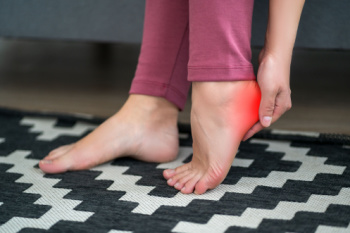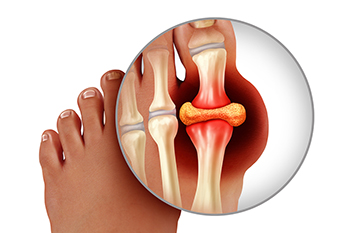Connect With Us
Blog
Items filtered by date: March 2024
Arthritis Can Cause Pain in the Feet and Ankles
Conditions Associated With Heel Spurs
 Heel spurs are bony growths that develop on the underside of the heel bone, often near the point where the plantar fascia connects to the bone. While they can be asymptomatic, heel spurs are frequently associated with certain foot conditions, serving as indicators of underlying issues. Primarily, they're linked with plantar fasciitis, a condition where the ligament running along the bottom of your foot becomes inflamed and causes heel pain. This inflammation can lead to the development of a spur. Heel spurs are also frequently associated with chronic conditions stemming from strain on the foot muscles and ligaments, or from repeated tearing of the membrane that covers the heel bone. Such strain and tearing can be due to excessive weight, poor shoe choices, or an active lifestyle without adequate foot support. The association of heel spurs with other conditions typically means there will be a comprehensive approach to treatment, which may include stretches, orthotic support, or lifestyle modifications to address the root cause of the pain. If you are suffering from a heel spur, it is suggested you make an appointment with a podiatrist who can diagnose the underlying problem and help you find relief.
Heel spurs are bony growths that develop on the underside of the heel bone, often near the point where the plantar fascia connects to the bone. While they can be asymptomatic, heel spurs are frequently associated with certain foot conditions, serving as indicators of underlying issues. Primarily, they're linked with plantar fasciitis, a condition where the ligament running along the bottom of your foot becomes inflamed and causes heel pain. This inflammation can lead to the development of a spur. Heel spurs are also frequently associated with chronic conditions stemming from strain on the foot muscles and ligaments, or from repeated tearing of the membrane that covers the heel bone. Such strain and tearing can be due to excessive weight, poor shoe choices, or an active lifestyle without adequate foot support. The association of heel spurs with other conditions typically means there will be a comprehensive approach to treatment, which may include stretches, orthotic support, or lifestyle modifications to address the root cause of the pain. If you are suffering from a heel spur, it is suggested you make an appointment with a podiatrist who can diagnose the underlying problem and help you find relief.
Heel spurs can be incredibly painful and sometimes may make you unable to participate in physical activities. To get medical care for your heel spurs, contact Philip K. Schrumpf, DPM from Active Feet Clinic. Our doctor will do everything possible to treat your condition.
Heels Spurs
Heel spurs are formed by calcium deposits on the back of the foot where the heel is. This can also be caused by small fragments of bone breaking off one section of the foot, attaching onto the back of the foot. Heel spurs can also be bone growth on the back of the foot and may grow in the direction of the arch of the foot.
Older individuals usually suffer from heel spurs and pain sometimes intensifies with age. One of the main condition's spurs are related to is plantar fasciitis.
Pain
The pain associated with spurs is often because of weight placed on the feet. When someone is walking, their entire weight is concentrated on the feet. Bone spurs then have the tendency to affect other bones and tissues around the foot. As the pain continues, the feet will become tender and sensitive over time.
Treatments
There are many ways to treat heel spurs. If one is suffering from heel spurs in conjunction with pain, there are several methods for healing. Medication, surgery, and herbal care are some options.
If you have any questions feel free to contact our office located in Missoula, MT . We offer the latest in diagnostic and treatment technology to meet your needs.
Various Ways of Testing for Gout

Gout, a painful form of arthritis, often causes intense swelling in a single joint, typically the big toe. Gout is the result of high levels of uric acid in the blood. The uric acid forms crystals in the joints that result in sudden and severe pain, called flare ups. Diagnostic lab tests for gout examine blood or joint fluid for uric acid levels or crystals, though not all cases show elevated uric acid levels. Imaging tests like X-rays, ultrasounds, or special CT scans can help show joint damage or uric acid crystals. Monitoring lab tests can track uric acid levels over time, with additional assessments of kidney function through creatinine and blood urea nitrogen, or BUN, tests. A urinalysis is used to detect uric acid in urine. Regular imaging tests monitor joint health to detect any damage caused by untreated gout. A podiatrist can conduct the appropriate diagnostic tests for gout. If you are experiencing toe joint pain or suspect gout, it is suggested that you schedule an appointment with a podiatrist.
Gout is a painful condition that can be treated. If you are seeking treatment, contact Philip K. Schrumpf, DPM from Active Feet Clinic. Our doctor will treat your foot and ankle needs.
What Is Gout?
Gout is a form of arthritis that is characterized by sudden, severe attacks of pain, redness, and tenderness in the joints. The condition usually affects the joint at the base of the big toe. A gout attack can occur at any random time, such as the middle of the night while you are asleep.
Symptoms
- Intense Joint Pain - Usually around the large joint of your big toe, and it most severe within the first four to twelve hours
- Lingering Discomfort - Joint discomfort may last from a few days to a few weeks
- Inflammation and Redness -Affected joints may become swollen, tender, warm and red
- Limited Range of Motion - May experience a decrease in joint mobility
Risk Factors
- Genetics - If family members have gout, you’re more likely to have it
- Medications - Diuretic medications can raise uric acid levels
- Gender/Age - Gout is more common in men until the age of 60. It is believed that estrogen protects women until that point
- Diet - Eating red meat and shellfish increases your risk
- Alcohol - Having more than two alcoholic drinks per day increases your risk
- Obesity - Obese people are at a higher risk for gout
Prior to visiting your podiatrist to receive treatment for gout, there are a few things you should do beforehand. If you have gout you should write down your symptoms--including when they started and how often you experience them, important medical information you may have, and any questions you may have. Writing down these three things will help your podiatrist in assessing your specific situation so that he or she may provide the best route of treatment for you.
If you have any questions, please feel free to contact our office located in Missoula, MT . We offer the newest diagnostic and treatment technologies for all your foot care needs.
What to Look for in Walking Shoes

When searching for the ideal walking shoes, prioritize comfort and fit above all else. Ensure that your shoes provide adequate support while accommodating the unique shape of your feet. Before shopping for walking shoes, it may be wise to visit a podiatrist for a gait analysis and to see if any foot abnormalities may indicate the need for custom-made orthotics. Look for shoes with cushioning and stability, but don't assume that more cushioning is always better. Instead, opt for a balance that promotes natural foot movement. Try on shoes later in the day when your feet are at their largest. Bring along socks of the thickness you typically wear, and test the shoes by taking a few laps around the store to assess comfort and fit. Ensure there's enough space for your toes to wiggle and that there's at least a finger's width of space between your longest toe and the front of the shoe. For help with foot problems associated with walking, it is suggested that you make an appointment with a podiatrist.
It is important to find shoes that fit you properly in order to avoid a variety of different foot problems. For more information about treatment, contact Philip K. Schrumpf, DPM from Active Feet Clinic. Our doctor will treat your foot and ankle needs.
Proper Shoe Fitting
Shoes have many different functions. They cushion our body weight, protect our feet, and allow us to safely play sports. You should always make sure that the shoes you wear fit you properly in order to avoid injuries and deformities such as: bunions, corns, calluses, hammertoes, plantar fasciitis, stress fractures, and more. It is important to note that although a certain pair of shoes might be a great fit for someone else, that doesn’t mean they will be a great fit for you. This is why you should always try on shoes before buying them to make sure they are worth the investment. Typically, shoes need to be replaced ever six months to one year of regular use.
Tips for Proper Shoe Fitting
- Select a shoe that is shaped like your foot
- Don’t buy shoes that fit too tight, expecting them to stretch to fit
- Make sure there is enough space (3/8” to ½”) for your longest toe at the end of each shoe when you are standing up
- Walk in the shoes to make sure they fit and feel right
- Don’t select shoes by the size marked inside the shoe, but by how the shoe fits your foot
The shoes you buy should always feel as good as they look. Shoes that fit properly will last longer, feel better, and improve your way of life each day.
If you have any questions, please feel free to contact our office located in Missoula, MT . We offer the newest diagnostic and treatment technologies for all your foot care needs.
Support in Diabetic Foot Care

Diabetes poses risks of foot ulcers and other foot problems, but proactive care can lessen these dangers. Regular checkups with a podiatrist are important for diabetic individuals. Besides professional care, daily self-checks are imperative. Interestingly, involving spouses in foot care can enhance vigilance. Research comparing diabetic individuals receiving guidance alone to those and their spouses found higher rates of foot checking in the coupled group. While both groups had similar levels of foot protection behavior, spousal support boosted overall foot care in the dyad group. This underscores the importance of involving loved ones and caregivers in diabetic foot care routines. If you have diabetes, it is suggested that you seek support and schedule regular appointments with a podiatrist for checkups. This will help individuals with diabetes to better prevent complications and maintain foot health.
Diabetic foot care is important in preventing foot ailments such as ulcers. If you are suffering from diabetes or have any other concerns about your feet, contact Philip K. Schrumpf, DPM from Active Feet Clinic. Our doctor can provide the care you need to keep you pain-free and on your feet.
Diabetic Foot Care
Diabetes affects millions of people every year. The condition can damage blood vessels in many parts of the body, especially the feet. Because of this, taking care of your feet is essential if you have diabetes, and having a podiatrist help monitor your foot health is highly recommended.
The Importance of Caring for Your Feet
- Routinely inspect your feet for bruises or sores.
- Wear socks that fit your feet comfortably.
- Wear comfortable shoes that provide adequate support.
Patients with diabetes should have their doctor monitor their blood levels, as blood sugar levels play such a huge role in diabetic care. Monitoring these levels on a regular basis is highly advised.
It is always best to inform your healthcare professional of any concerns you may have regarding your feet, especially for diabetic patients. Early treatment and routine foot examinations are keys to maintaining proper health, especially because severe complications can arise if proper treatment is not applied.
If you have any questions please feel free to contact our office located in Missoula, MT . We offer the newest diagnostic and treatment technologies for all your foot and ankle needs.
Gout Pain Can Be Managed
Blog Archives
- August 2024
- July 2024
- June 2024
- May 2024
- April 2024
- March 2024
- February 2024
- January 2024
- December 2023
- November 2023
- October 2023
- September 2023
- August 2023
- July 2023
- June 2023
- May 2023
- April 2023
- March 2023
- February 2023
- January 2023
- December 2022
- November 2022
- October 2022
- September 2022
- August 2022
- July 2022
- June 2022
- May 2022
- April 2022
- March 2022
- February 2022
- January 2022
- December 2021
- November 2021
- October 2021
- September 2021
- August 2021
- July 2021
- June 2021
- May 2021
- April 2021
- March 2021
- February 2021
- January 2021
- December 2020
- November 2020
- October 2020
- September 2020
- August 2020
- July 2020
- June 2020
- May 2020
- April 2020
- March 2020
- February 2020
- January 2020
- December 2019
- November 2019
- October 2019
- September 2019
- August 2019
- July 2019
- June 2019
- May 2019
- April 2019
- March 2019


